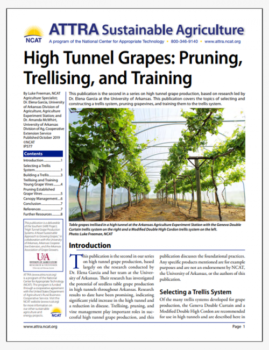High Tunnel Grapes: Pruning, Trellising, and Training
By Luke Freeman, NCAT Agriculture Specialist; Dr. Elena Garcia, University of Arkansas Division of Agriculture, Agriculture Experiment Station; and Dr. Amanda McWhirt, University of Arkansas Division of Agriculture, Cooperative Extension Service
Abstract
This publication is the second in a series on high tunnel grape production, based on research led by Dr. Elena Garcia at the University of Arkansas. It covers the topics of selecting and constructing a trellis system, pruning grapevines, and training them to the trellis system.
Introduction
This publication is the second in our series on high tunnel grape production, based largely on the research conducted by Dr. Elena Garcia and her team at the University of Arkansas. Their research has investigated the potential of seedless table grape production in high tunnels throughout Arkansas. Research results to date have been promising, indicating significant yield increase in the high tunnel and a reduction in disease. Trellising, pruning, and vine management play important roles in successful high tunnel grape production, and this publication discusses the foundational practices. Any specific products mentioned are for example purposes and are not an endorsement by NCAT, the University of Arkansas, or the authors of this publication.
Selecting a Trellis System
Of the many trellis systems developed for grape production, the Geneva Double Curtain and a Modified Double High Cordon are recommended for use in high tunnels and are described here in detail. Both of these trellis systems are well suited for the vigorous growth of grapevines in high tunnels and were utilized in the research trials conducted by the University of Arkansas High Tunnel Grape Project team.
 The Geneva Double Curtain (GDC) trellis system is well-suited for the center rows of a high tunnel. Graphic: Amy Smith, NCAT |
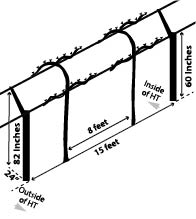 The Modified Double High Cordon (MDC) trellis system is well-suited for outer rows of the high tunnel, next to the sidewalls. Graphic: Amy Smith, NCAT |
Geneva Double Curtain (GDC)
The Geneva Double Curtain (GDC) trellis is well-suited for vigorous American-type grapes, which makes it ideal to support the rampant growth of grapevines in a high tunnel. The GDC trellis creates two horizontally divided curtains of shoots positioned on either side of the row, supported by fruiting wires on cross arms that are typically three to four feet apart and 5.5 feet high (Strik, 2011). Vines can be split into two or four cordons, utilizing one or both of the fruiting wires, respectively. Splitting the vine between four cordons helps control vigor while also opening up the canopy to improve air circulation and light exposure. Vines on GDC are typically spur-pruned with shoots trained to hang vertically downwards in two parallel curtains.
In University of Arkansas high tunnel research, the GDC trellis is utilized for the grapes grown in a center row, down the middle of the tunnel. Posts are 68 inches tall and set 15 feet apart. A mid-wire is run though the posts at 56 inches above the ground, which will support the trunk of the vines. A cross T-brace that is 48 inches long is run across the top of each post to support the fruiting wires on either side of the trellis. Vines are spaced eight feet apart and trained to two cordons on alternating fruiting wires, so each cordon stretches eight feet in either direction from the trunk. Alternatively, vines could be trained to four cordons (two per fruiting wire), with each cordon stretching four feet in either direction.
Modified Double High Cordon (MDC)
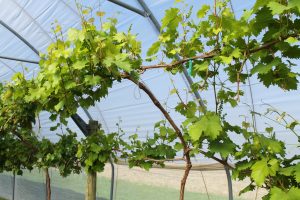
Table grapes growing on a Modified Double High Cordon (MDC) trellis system in a high tunnel. Photo: Luke Freeman, NCAT
The Modified Double High Cordon (MDC) is a modification of the GDC. It is used by the University of Arkansas research team to make efficient use of space on the outer rows in the high tunnel. This system positions fruit on only one side of the trellis. The trellis includes two fruiting wires that support four cordons per vine, with the interior wire higher than the outer wire to make use of the higher ceiling towards the center of the high tunnel. The lower fruiting wire is 60 inches high, running over the top of wooden posts set 15 feet apart in the row. The high fruiting wire is 82 inches above the ground, supported by arms attached to the 60-inch posts set at 45° angles reaching upwards and inwards towards the middle of the tunnel. On a horizontal plane, the two fruiting wires are 24 inches apart, in addition to being 22 inches apart on a vertical plane.
In the MDC system, the trunk of the vine is trained so that it extends to the lower wire, then continues up and over to the high wire, where it ends with two cordons. Two cordons branch from the trunk below each fruiting wire, so that the vine supports four cordons in total. Each cordon measures four feet, so that the tips of cordons from neighboring vines nearly touch. Similar to the GDC, the goal of the MDC system is two parallel curtains of shoots hanging vertically downwards. Elevating the interior fruiting wire to 82 inches above ground level increases light exposure and also serves to open the canopy for better air movement.
Yield differences have been measured between the grapes grown on MDC on the eastern side of the tunnel compared to the western side, in research high tunnels oriented north to south. In 2017 trials at the University of Arkansas, total yield for three cultivars tested (Gratitude, Faith, and Jupiter) was higher on the MDC East trellis compared to the West trellis; also the number of clusters per vine was higher for both Faith and Gratitude on the eastern side.
Building a Trellis
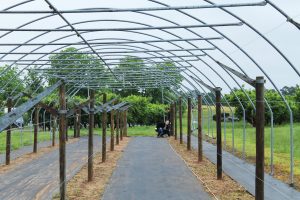
The trellis system should be in place before planting grape vines. Photo: Luke Freeman, NCAT
The specifics of how you build your grape trellis will depend on the system you select, but there are many common factors across all trellis systems discussed here. It will behoove you to set your trellis posts before planting the grape vines in the high tunnel, so as to avoid damaging vines in the process of setting posts. In addition, it may be easier to set trellis posts before the high tunnel construction is finished so that the high tunnel bows do not obstruct the equipment you are using to set posts. However, you will want to have the ground anchors for the high tunnel laid out and set before beginning on the trellis to know exactly where the footprint of the high tunnel will be.
The end posts for your trellis should be nine to 10 feet tall and 4.5 to six inches in diameter, set three feet into the ground at a slight angle leaning away from the row. Treated pine or locust posts are commonly used, and pressure-treated posts will last an additional 10 to 15 years (Dami et al., 2005). Organic growers are not allowed to use pressure-treated wood, however, and should refer to the ATTRA publication Pressure-Treated Wood: Organic and Natural Alternatives for an explanation of the rule and a summary of options. Products such as WoodGuard™ are available for organic growers and will have a lifespan similar to pressure-treated lumber, though the cost will likely be higher.
A screw anchor or H-brace should be used to brace the end post. The line posts used within the row should be eight to nine feet tall, at least three inches in diameter, and set three feet deep. Although field spacing for line posts is typically 18 to 24 feet, in the high tunnel it is recommended to space line posts 15 feet apart to support the vigorous growth of the vines and heavy fruit set. High-tensile-strength galvanized steel wire should be used for the trellis wire, 12-gauge or heavier. A wire tightener should be inserted in each training wire to allow for tightening each winter after pruning. It is recommended to use metal cross-arms for the GDC trellis system and metal support arms for the MDC system.
Trellis Cost Estimate
The cost for establishing a trellis system will depend on the system selected and the size of the high tunnel. A rough cost estimate is between $1,500 and $3,000 per acre. The systems used for the University of Arkansas project averaged $2,500 per acre because of additional hardware required for the GDC and MDC trellis systems.
Trellising and Training Young Grape Vines
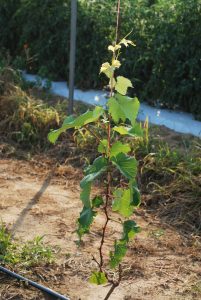
A young grape vine is trained to the trellis using a cord tied to the lower trellis wire. Photo: Luke Freeman, NCAT
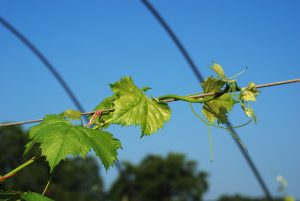
Once the shoot reaches the high wire on the MDC trellis system, it can be wrapped around the wire to become one of the four cordons. Photo: Luke Freeman, NCAT
The task of training your grapevines will begin soon after planting and will be an important activity for the establishment year. Your main goal for the first year will be to develop a straight trunk that reaches to the top trellis wire. The trunk of the vine should be trained by selecting the strongest shoot and training it to a cord that is tied to the middle trellis wire. All other shoots should be pruned or rubbed off. For vigorous vines in the high tunnel, it may even be possible to train shoots for cordons in the first year as well. In University of Arkansas research, seedless table grapes grown in a high tunnel were so vigorous in their growth habit that shoots were selected and trained for cordons by the end of the establishment year.
For a GDC trellis, once the main shoot reaches above the middle wire, the shoot should be laid over the top of the wire and directed toward one of the fruiting wires. Once the shoot reaches the fruiting wire, its growth should be directed so that it continues to grow down the fruiting wire in one direction, with the shoot loosely wrapped around the wire and loosely tied if needed. A second shoot emerging from the main shoot below the junction with the fruiting wire should be selected and trained to become the second cordon facing the opposite direction from the first. As mentioned above, in the University of Arkansas research, high tunnel vines on the GDC trellis are managed so that each vine has two cordons on one side of the trellis only. The method will be slightly different if the goal is four cordons per vine.
For vines on an MDC trellis, once the main shoot reaches above the lower fruiting wire, it should be laid over the top of the wire, tied loosely, and directed towards the high fruiting wire. Once the shoot reaches the high wire, it should be trained to become one of the cordons. The shoot will need to be wrapped loosely around the high wire and tied to hold it in place. Three other shoots will be selected to become the remaining cordons. Loosely wrap and tie them to the wire in a similar fashion to make two cordons per wire.
The cordon shoots should be pinched or tipped when they reach the desired length (eight feet for the GDC and four feet for the MDC, in this scenario). These new cordons should be loosely wrapped about one full turn around the trellis wire, securely attached on the ends with wire twist ties, and loosely attached at the base with plastic chain-lock or similar ties that are loosely fastened to allow room for the vine to expand. Establishing the cordons may take as long as two full seasons, but the experience of the University of Arkansas research team has been that cordons can be established by the end of the first year for table grapes in a high tunnel.
Pruning Established Grape Vines
 Pruning should take place in late winter while the grape vines are still dormant. Photo: Luke Freeman, NCAT |
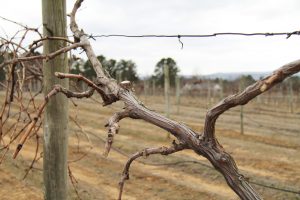 Canes should be pruned back so that there are two to six buds per spur. Photo: Luke Freeman, NCAT |
Pruning grape vines is an essential activity to maintain the balance between vegetative growth and fruiting of the vine, with the goal of producing a good yield of high-quality fruit. In the high tunnel, where grape vines have increased vigor, pruning serves to control vegetative growth and ensure that the canopy does not become too dense. Winter pruning should take place between January and early March, when the vines are fully dormant. Depending on previous-season vine vigor, up to 90% of the previous season’s wood might need to be removed during winter pruning (Strik, 2011). There are two pruning styles for grapes: spur pruning and cane pruning. This publication focuses on spur pruning, as it is the style utilized by the Arkansas high tunnel grape research team for their seedless grapes grown on GDC and MDC trellis systems.
Spur Pruning
Spur pruning involves establishing semi-permanent cordons with fruiting spurs. Each fruiting spur is a 1-year-old cane that has been pruned back to two to six buds, which will produce the next year’s fruit. In the winter after the cordons have been established, shoots emerging from the cordon should be pruned back to create spurs, each with two to three buds. These spurs should be spaced four to six inches apart, leaving roughly 30 buds per plant (Strik, 2011). In subsequent years, the canes should be pruned back to two to six bud spurs, leaving enough spurs so there are 20 to 60 buds per plant. A method for determining how many buds to retain, called balanced pruning, is discussed in the next section.
Recognizing productive wood is important when deciding which 1-year-old canes to retain as spurs, as some canes will be more fruitful than others. One sign of productive wood is good sun exposure to both the shoot and leaves. Avoid retaining “shade canes” that have been growing towards the interior of the canopy. Canes should be pencil-size in diameter (1/4 inch), healthy, and free of disease such as powdery mildew or Phomopsis. The bark should be a bright, uniform reddish-brown color with a distance of five to eight inches between each node (Dami et al., 2005).
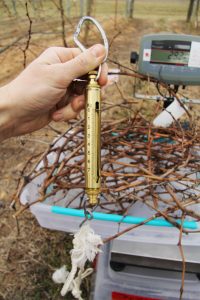
A scale should be used weigh the 1-year-old wood that was removed for balanced pruning. Photo: Luke Freeman, NCAT
Balanced Pruning
Balanced pruning is a method to estimate the potential fruit capacity of an individual vine in order to determine how many fruiting buds to retain. Although eventually the formula will be internalized and experienced pruners will develop a “feel” for how much wood to retain, this method will be helpful for beginners and those who wish to check their pruning methods. The steps for balanced pruning are as follows (Creasy and Creasy, 2009):
-
- Estimate the weight of 1-year-old wood to establish a reference point: Begin by selecting the fruiting spurs to retain on one plant and cut out all other 1-year wood, setting aside to weigh. Weigh the 1-year wood prunings that were removed to determine the weight of fruit capacity of the vine. Use a scale that measures to the ¼ pound. Older wood removed should not be counted.
- Apply the weight of 1-year-old prunings to the balanced pruning formula to determine the number of buds to retain: For seedless table grapes such as Mars, use 30 + 10. This means that 30 buds will be retained for the first pound of prunings and 10 additional buds for each additional pound. The formula can be written as: (number of buds to retain) = 30 + 10 X (where X = pounds of prunings – 1). Using this formula, if 2.8 pounds of prunings were removed, then 48 buds should be retained [30 + (10 X 1.8) = 48].
- Count the number of buds you retained on fruiting spurs and compare to the result of the formula: If the number of buds remaining on the plant is higher than the amount indicated by the formula, continue to prune until the desired number of buds is achieved.
Canopy Management
There are several additional management practices that serve to improve air movement and leaf drying within the canopy, improve spray penetration and disease control, improve fruit composition and character, increase bud fruitfulness, and improve winter hardiness. For high tunnel grapes, canopy management practices are especially important for controlling vigorous vine growth and excessive shading.
Shoot thinning refers to the removal of suckers (unwanted shoots) from the trunk or cordon and the removal of unfruitful shoots in order to achieve the desired number of shoots per vine. For the GDC trellis system, the goal is 64 to 96 shoots per vine (Dami et al., 2005). Shoot thinning should take place early in the season, when shoots are one to 12 inches long and can be easily rubbed or pinched off without damaging the vine.
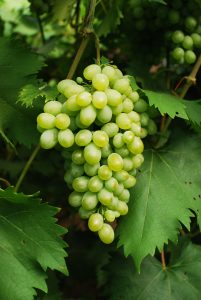
A ‘Gratitude’ grape cluster grown in a high tunnel at the Arkansas Agriculture Experiment Station. Photo: Luke Freeman, NCAT
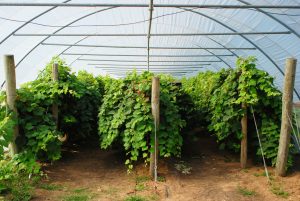
Canopy management practices are very important in the high tunnel to control vigorous vine growth and excessive shading of the fruit. Photo: Luke Freeman, NCAT
Shoot positioning refers to combing shoots and arranging in the desired direction. In the case of the GDC and MDC trellis systems, shoots should be combed vertically downwards and untangled to promote an open canopy with two distinct vertical curtains. Shoot positioning should be accomplished as soon as possible after bloom.
Cluster thinning refers to the removal of grape clusters prior to verasion (or fruit coloring), in order to improve berry size and quality. Cluster thinning can be accomplished prior to bloom with the removal of excess flower clusters during the time of shoot thinning. This practice will improve berry set and increase berry size. Cluster thinning can also be accomplished after fruit set with the removal of green clusters. After fruit set, cluster thinning will not have as drastic an effect on berry size, but it can still improve berry quality and quicken ripening (Dami et al., 2005). A standard rule of thumb for cluster thinning is that all clusters should be removed from shoots that are less than eight inches long. For shoots eight to 20 inches, one cluster should be retained. For shoots that are more than 20 inches long, two clusters can be retained.
Leaf removal can assist with air movement and spray penetration around the grape clusters and improve sunlight exposure to achieve better color and higher grape quality. Leaves and shoots should only be removed from the shade-side of the canopy, so as to not create sunburn from direct sun exposure in the afternoon. Sunburn of grapes will likely be less of an issue in the high tunnel due to the diffused light environment, but caution should still be used. Only two to four leaves per shoot should be removed after fruit set if leaf removal is being practiced (Strik, 2011).
Shoot hedging, or skirting, refers to the tipping of shoots that grow beyond their allocated space in the trellis system. For the DGC trellis, shoots that grow beyond five feet from the trellis wire can be pruned back to the desired five feet. This will likely need to be practiced in the high tunnel because of the increased vine vigor; however, hedging should not be practiced after verasion as it can delay fruit maturity and decrease winter hardiness (Dami et al., 2005).
Conclusion
Proper pruning, trellising, and training methods are critical for success with high tunnel grapes. The High Tunnel Grape team at the University of Arkansas has experienced success with the GDC and MDC trellis systems described above, though other trellis systems may also prove successful. The key to vine management in the high tunnel is controlling vigor and keeping the canopy open to allow for light penetration and reduce disease pressure. Additional effort will be needed for canopy management in high tunnel systems, in order to keep an open canopy with ample air movement and light exposure.
High Tunnel Grapes: Pruning, Trellising, and Training
By Luke Freeman, NCAT Agriculture Specialist; Dr. Elena Garcia, University of Arkansas Division of Agriculture, Agriculture Experiment Station; and Dr. Amanda McWhirt, University of Arkansas Division of Agriculture, Cooperative Extension Service
Published October 2019
© NCAT 2019
IP577
Slot 603
This publication was produced by the National Center for Appropriate Technology, for the Southern SARE Project, “High Tunnel Grape Production Systems: A Novel Sustainable Approach to Growing Grapes,” in collaboration with the University of Arkansas, Arkansas Cooperative Extension, and the Arkansas Association of Grape Growers. ATTRA.NCAT.ORG

